Arachnid
Arachnida (/əˈræknɪdə/) is a class of joint-legged invertebrate animals (arthropods), in the subphylum Chelicerata. Spiders are the largest order in the class, which also includes scorpions, ticks, mites, harvestmen, and solifuges.[1] In 2019, a molecular phylogenetic study also placed horseshoe crabs in Arachnida.[2]
| Arachnids | |
|---|---|
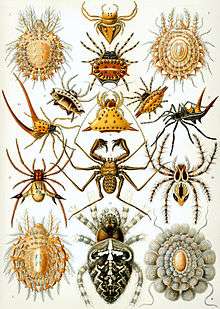 | |
| "Arachnida" from Ernst Haeckel's Kunstformen der Natur, 1904 | |
| Scientific classification | |
| Kingdom: | Animalia |
| Phylum: | Arthropoda |
| Subphylum: | Chelicerata |
| Class: | Arachnida Lamarck, 1801 |
| Orders | |
Almost all adult arachnids have eight legs, although the front pair of legs in some species has converted to a sensory function, while in other species, different appendages can grow large enough to take on the appearance of extra pairs of legs. The term is derived from the Greek word ἀράχνη (aráchnē), from the myth of the hubristic human weaver Arachne, who was turned into a spider.[3]
Almost all extant arachnids are terrestrial, living mainly on land. However, some inhabit freshwater environments and, with the exception of the pelagic zone, marine environments as well. They comprise over 100,000 named species.
Morphology
Almost all adult arachnids have eight legs, unlike adult insects which all have six legs. However, arachnids also have two further pairs of appendages that have become adapted for feeding, defense, and sensory perception. The first pair, the chelicerae, serve in feeding and defense. The next pair of appendages, the pedipalps, have been adapted for feeding, locomotion, and/or reproductive functions. In Solifugae, the palps are quite leg-like, so that these animals appear to have ten legs. The larvae of mites and Ricinulei have only six legs; a fourth pair usually appears when they moult into nymphs. However, mites are variable: as well as eight, there are adult mites with six or even four legs.[4]
Arachnids are further distinguished from insects by the fact they do not have antennae or wings. Their body is organized into two tagmata, called the prosoma, or cephalothorax, and the opisthosoma, or abdomen. (However, there is currently neither fossil nor embryological evidence that arachnids ever had a separate thorax-like division, so the validity of the term cephalothorax, which means a fused cephalon, or head, and thorax, has been questioned. There are also arguments against use of 'abdomen', as the opisthosoma of many arachnids contains organs atypical of an abdomen, such as a heart and respiratory organs.[5]) The prosoma, or cephalothorax, is usually covered by a single, unsegmented carapace. The abdomen is segmented in the more primitive forms, but varying degrees of fusion between the segments occur in many groups. It is typically divided into a preabdomen and postabdomen, although this is only clearly visible in scorpions, and in some orders, such as the Acari, the abdominal sections are completely fused.[6] A telson is present in scorpions, where it has been modified to a stinger, and in the Schizomida, whip scorpions and Palpigradi.[7]
Like all arthropods, arachnids have an exoskeleton, and they also have an internal structure of cartilage-like tissue, called the endosternite, to which certain muscle groups are attached. The endosternite is even calcified in some Opiliones.[8]
Locomotion
Most arachnids lack extensor muscles in the distal joints of their appendages. Spiders and whipscorpions extend their limbs hydraulically using the pressure of their hemolymph.[9] Solifuges and some harvestmen extend their knees by the use of highly elastic thickenings in the joint cuticle.[9] Scorpions, pseudoscorpions and some harvestmen have evolved muscles that extend two leg joints (the femur-patella and patella-tibia joints) at once.[10][11] The equivalent joints of the pedipalps of scorpions though, are extended by elastic recoil.[12]
Physiology
There are characteristics that are particularly important for the terrestrial lifestyle of arachnids, such as internal respiratory surfaces in the form of tracheae, or modification of the book gill into a book lung, an internal series of vascular lamellae used for gas exchange with the air.[13] While the tracheae are often individual systems of tubes, similar to those in insects, ricinuleids, pseudoscorpions, and some spiders possess sieve tracheae, in which several tubes arise in a bundle from a small chamber connected to the spiracle. This type of tracheal system has almost certainly evolved from the book lungs, and indicates that the tracheae of arachnids are not homologous with those of insects.[14]
Further adaptations to terrestrial life are appendages modified for more efficient locomotion on land, internal fertilisation, special sensory organs, and water conservation enhanced by efficient excretory structures as well as a waxy layer covering the cuticle.
The excretory glands of arachnids include up to four pairs of coxal glands along the side of the prosoma, and one or two pairs of Malpighian tubules, emptying into the gut. Many arachnids have only one or the other type of excretory gland, although several do have both. The primary nitrogenous waste product in arachnids is guanine.[14]
Arachnid blood is variable in composition, depending on the mode of respiration. Arachnids with an efficient tracheal system do not need to transport oxygen in the blood, and may have a reduced circulatory system. In scorpions and some spiders, however, the blood contains haemocyanin, a copper-based pigment with a similar function to haemoglobin in vertebrates. The heart is located in the forward part of the abdomen, and may or may not be segmented. Some mites have no heart at all.[14]
Diet and digestive system
Arachnids are mostly carnivorous, feeding on the pre-digested bodies of insects and other small animals. Only in the harvestmen and among mites, such as the house dust mite, is there ingestion of solid food particles, and thus exposure to internal parasites,[15] although it is not unusual for spiders to eat their own silk. Several groups secrete venom from specialized glands to kill prey or enemies. Several mites and ticks are parasites, some of which are carriers of disease.
Arachnids produce digestive juices in their stomachs, and use their pedipalps and chelicerae to pour them over their dead prey. The digestive juices rapidly turn the prey into a broth of nutrients, which the arachnid sucks into a pre-buccal cavity located immediately in front of the mouth. Behind the mouth is a muscular, sclerotised pharynx, which acts as a pump, sucking the food through the mouth and on into the oesophagus and stomach. In some arachnids, the oesophagus also acts as an additional pump.
The stomach is tubular in shape, with multiple diverticula extending throughout the body. The stomach and its diverticula both produce digestive enzymes and absorb nutrients from the food. It extends through most of the body, and connects to a short sclerotised intestine and anus in the hind part of the abdomen.[14]
Senses
Arachnids have two kinds of eyes: the lateral and median ocelli. The lateral ocelli evolved from compound eyes and may have a tapetum, which enhances the ability to collect light. With the exception of scorpions, which can have up to five pairs of lateral ocelli, there are never more than three pairs present. The median ocelli develop from a transverse fold of the ectoderm. The ancestors of modern arachnids probably had both types, but modern ones often lack one type or the other.[15] The cornea of the eye also acts as a lens, and is continuous with the cuticle of the body. Beneath this is a transparent vitreous body, and then the retina and, if present, the tapetum. In most arachnids, the retina probably does not have enough light sensitive cells to allow the eyes to form a proper image.[14]
In addition to the eyes, almost all arachnids have two other types of sensory organs. The most important to most arachnids are the fine sensory hairs that cover the body and give the animal its sense of touch. These can be relatively simple, but many arachnids also possess more complex structures, called trichobothria.
Finally, slit sense organs are slit-like pits covered with a thin membrane. Inside the pit, a small hair touches the underside of the membrane, and detects its motion. Slit sense organs are believed to be involved in proprioception, and possibly also hearing.[14]
Reproduction
Arachnids may have one or two gonads, which are located in the abdomen. The genital opening is usually located on the underside of the second abdominal segment. In most species, the male transfers sperm to the female in a package, or spermatophore. Complex courtship rituals have evolved in many arachnids to ensure the safe delivery of the sperm to the female.[14] Members of many orders exhibit sexual dimorphism.[16]
Arachnids usually lay yolky eggs, which hatch into immatures that resemble adults. Scorpions, however, are either ovoviviparous or viviparous, depending on species, and bear live young. In most arachnids only the females provide parental care, with harvestmen being one of the few exceptions.
Taxonomy and evolution
Phylogeny
The phylogenetic relationships among the main subdivisions of arthropods have been the subject of considerable research and dispute for many years. A consensus emerged from about 2010 onwards, based on both morphological and molecular evidence. Extant (living) arthropods are a monophyletic group and are divided into three main clades: chelicerates (including arachnids), pancrustaceans (the paraphyletic crustaceans plus insects and their allies), and myriapods (centipedes, millipedes and allies).[17][18][19][20][21] The three groups are related as shown in the cladogram below.[19] Including fossil taxa does not fundamentally alter this view, although it introduces some additional basal groups.[22]
| Arthropoda |
| ||||||||||||
The extant chelicerates comprise two marine groups: sea spiders and horseshoe crabs, and the terrestrial arachnids. These have been thought to be related as shown below.[18][21] (Pycnogonida (sea spiders) may be excluded from the chelicerates, which are then identified as the group labelled "Euchelicerata".[23]) A 2019 analysis nests Xiphosura deeply within Arachnida.[2]
| Chelicerata |
| ||||||||||||
Discovering relationships within the arachnids has proven difficult as of March 2016, with successive studies producing different results. A study in 2014, based on the largest set of molecular data to date, concluded that there were systematic conflicts in the phylogenetic information, particularly affecting the orders Acariformes, Parasitiformes and Pseudoscorpiones, which have had much faster evolutionary rates. Analyses of the data using sets of genes with different evolutionary rates produced mutually incompatible phylogenetic trees. The authors favoured relationships shown by more slowly evolving genes, which demonstrated the monophyly of Chelicerata, Euchelicerata and Arachnida, as well as of some clades within the arachnids. The diagram below summarizes their conclusions, based largely on the 200 most slowly evolving genes; dashed lines represent uncertain placements.[21]
|
Arachnopulmonata |
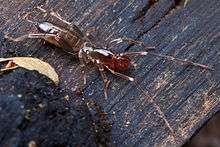
Tetrapulmonata, here consisting of Araneae, Amblypygi and Thelyphonida (Schizomida was not included in the study), received strong support. The addition of Scorpiones to produce a clade called Arachnopulmonata was also well supported. Pseudoscorpiones may also belong here, possibly as the sister of Scorpiones. Somewhat unexpectedly, there was support for a clade comprising Opiliones, Ricinulei and Solifugae, a combination not found in most other studies.[21]
In early 2019, a molecular phylogenetic analysis placed the horseshoe crabs, Xiphosura, as the sister group to Ricinulei. It also grouped pseudoscorpions with mites and ticks, which the authors considered may be due to long branch attraction.[2]
| |||||||||||||||||||||||||||||||||||||||||||||||||||||||||||||||||||
Morphological analyses including fossils tend to recover the Tetrapulmonata, including the extinct group the Haptopoda,[24][25][26][27][28] but recover other ordinal relationships with low support.
Fossil history

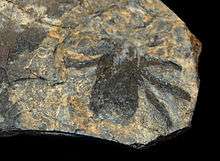
The Uraraneida are an extinct order of spider-like arachnids from the Devonian and Permian.[29]
A fossil arachnid in 100 million year old (mya) amber from Myanmar, Chimerarachne yingi, has spinnerets (to produce silk); it also has a tail, like the Palaeozoic Uraraneida, some 200 million years after other known fossils with tails. The fossil resembles the most primitive living spiders, the mesotheles.[30][24]
Taxonomy
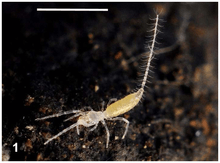
The subdivisions of the arachnids are usually treated as orders. Historically, mites and ticks were treated as a single order, Acari. However, molecular phylogenetic studies suggest that the two groups do not form a single clade, with morphological similarities being due to convergence. They are now usually treated as two separate taxa – Acariformes, mites, and Parasitiformes, ticks – which may be ranked as orders or superorders. The arachnid subdivisions are listed below alphabetically; numbers of species are approximate.
- Acariformes – mites (32,000 species)
- Amblypygi – "blunt rump" tail-less whip scorpions with front legs modified into whip-like sensory structures as long as 25 cm or more (153 species)
- Araneae – spiders (40,000 species)
- †Haptopoda – extinct arachnids apparently part of the Tetrapulmonata, the group including spiders and whip scorpions (1 species)
- Opilioacariformes – harvestman-like mites (10 genera)
- Opiliones – phalangids, harvestmen or daddy-long-legs (6,300 species)
- Palpigradi – microwhip scorpions (80 species)
- Parasitiformes – ticks (12,000 species)
- †Phalangiotarbi – extinct arachnids of uncertain affinity (30 species)
- Pseudoscorpionida – pseudoscorpions (3,000 species)
- Ricinulei – ricinuleids, hooded tickspiders (60 species)
- Schizomida – "split middle" whip scorpions with divided exoskeletons (220 species)
- Scorpiones – scorpions (2,000 species)
- Solifugae – solpugids, windscorpions, sun spiders or camel spiders (900 species)
- Thelyphonida (also called Uropygi) – whip scorpions or vinegaroons, forelegs modified into sensory appendages and a long tail on abdomen tip (100 species)
- †Trigonotarbida – extinct (late Silurian Early Permian)
- †Uraraneida – extinct spider-like arachnids, but with a "tail" and no spinnerets (2 species)
- Xiphosura – horseshoe crabs (4 living species)[2]
It is estimated that 98,000 arachnid species have been described, and that there may be up to 600,000 in total.[31]
See also
- Arachnophobia
- Endangered spiders
- Glossary of spider terms
- List of extinct arachnids
References
- Cracraft, Joel & Donoghue, Michael, eds. (2004). Assembling the Tree of Life. Oxford University Press. p. 297.
- Ballesteros, J. A.; Sharma, P. P. (2019). "A Critical Appraisal of the Placement of Xiphosura (Chelicerata) with Account of Known Sources of Phylogenetic Error". Systematic Biology. 68 (6): 896–917. doi:10.1093/sysbio/syz011. PMID 30917194.
- "Arachnid". Oxford English Dictionary (2nd ed.). 1989.
- Schmidt, Günther (1993). Giftige und gefährliche Spinnentiere [Poisonous and dangerous arachnids] (in German). Westarp Wissenschaften. p. 75. ISBN 978-3-89432-405-6.
- Shultz, Stanley; Shultz, Marguerite (2009). The Tarantula Keeper's Guide. Hauppauge, New York: Barron's. p. 23. ISBN 978-0-7641-3885-0.
- Ruppert, E.; Fox, R. & Barnes, R. (2007). Invertebrate Zoology: A Functional Evolutionary Approach (7th ed.). Thomson Learning. ISBN 978-0-03-025982-1.
- The Colonisation of Land: Origins and Adaptations of Terrestrial Animals
- Kovoor, J. (1978). "Natural calcification of the prosomatic endosternite in the Phalangiidae (Arachnida:Opiliones)". Calcified Tissue Research. 26 (3): 267–269. doi:10.1007/BF02013269. PMID 750069.
- Sensenig, Andrew T. & Shultz, Jeffrey W. (February 15, 2003). "Mechanics of Cuticular Elastic Energy Storage in Leg Joints Lacking Extensor Muscles in Arachnids". Journal of Experimental Biology. 206 (4): 771–784. doi:10.1242/jeb.00182. ISSN 1477-9145. PMID 12517993.
- Shultz, Jeffrey W. (February 6, 2005). "Evolution of locomotion in arachnida: The hydraulic pressure pump of the giant whipscorpion, Mastigoproctus giganteus (Uropygi)". Journal of Morphology. 210 (1): 13–31. doi:10.1002/jmor.1052100103. ISSN 1097-4687. PMID 29865543.
- Shultz, Jeffrey W. (January 1, 1992). "Muscle Firing Patterns in Two Arachnids Using Different Methods of Propulsive Leg Extension". Journal of Experimental Biology. 162 (1): 313–329. ISSN 1477-9145. Retrieved 2012-05-19.
- Sensenig, Andrew T. & Shultz, Jeffrey W. (2004). "Elastic energy storage in the pedipedal joints of scorpions and sun-spiders (Arachnida, Scorpiones, Solifugae)". Journal of Arachnology. 32 (1): 1–10. doi:10.1636/S02-73. ISSN 0161-8202.
- Garwood, Russell J. & Edgecombe, Gregory D. (September 2011). "Early Terrestrial Animals, Evolution, and Uncertainty". Evolution: Education and Outreach. 4 (3): 489–501. doi:10.1007/s12052-011-0357-y.
- Barnes, Robert D. (1982). Invertebrate Zoology. Philadelphia, PA: Holt-Saunders International. pp. 596–604. ISBN 978-0-03-056747-6.
- Machado, Glauco; Pinto-da-Rocha, Ricardo & Giribet, Gonzalo (2007). Pinto-da-Rocha, Ricardo; Machado, Glauco & Giribet, Gonzalo (eds.). Harvestmen: the Biology of Opiliones. Harvard University Press. ISBN 978-0-674-02343-7.
- McLean, Callum J.; Garwood, Russell J.; Brassey, Charlotte A. (2018). "Sexual dimorphism in the Arachnid orders". PeerJ. 6: e5751. doi:10.7717/peerj.5751. ISSN 2167-8359.
- Meusemann, Karen; Reumont, Björn M. von; Simon, Sabrina; Roeding, Falko; Strauss, Sascha; Kück, Patrick; Ebersberger, Ingo; Walzl, Manfred; Pass, Günther; Breuers, Sebastian; Achter, Viktor; Haeseler, Arndt von; Burmester, Thorsten; Hadrys, Heike; Wägele, J. Wolfgang & Misof, Bernhard (2010). "A Phylogenomic Approach to Resolve the Arthropod Tree of Life". Molecular Biology and Evolution. 27 (11): 2451–2464. doi:10.1093/molbev/msq130. PMID 20534705.
- Regier, Jerome C.; Shultz, Jeffrey W.; Zwick, Andreas; Hussey, April; Ball, Bernard; Wetzer, Regina; Martin, Joel W. & Cunningham, Clifford W. (2010). "Arthropod relationships revealed by phylogenomic analysis of nuclear protein-coding sequences". Nature. 463 (7284): 1079–1083. Bibcode:2010Natur.463.1079R. doi:10.1038/nature08742. PMID 20147900.
- Rota-Stabelli, Omar; Campbell, Lahcen; Brinkmann, Henner; Edgecombe, Gregory D.; Longhorn, Stuart J.; Peterson, Kevin J.; Pisani, Davide; Philippe, Hervé & Telford, Maximilian J. (2010). "A congruent solution to arthropod phylogeny: phylogenomics, microRNAs and morphology support monophyletic Mandibulata". Proceedings of the Royal Society of London B: Biological Sciences. 278 (1703): 298–306. doi:10.1098/rspb.2010.0590. PMC 3013382. PMID 20702459.
- Campbell, Lahcen I.; Rota-Stabelli, Omar; Edgecombe, Gregory D.; Marchioro, Trevor; Longhorn, Stuart J.; Telford, Maximilian J.; Philippe, Hervé; Rebecchi, Lorena; Peterson, Kevin J. & Pisani, Davide (2011). "MicroRNAs and phylogenomics resolve the relationships of Tardigrada and suggest that velvet worms are the sister group of Arthropoda". Proceedings of the National Academy of Sciences. 108 (38): 15920–15924. Bibcode:2011PNAS..10815920C. doi:10.1073/pnas.1105499108. PMC 3179045. PMID 21896763.
- Sharma, Prashant P.; Kaluziak, Stefan T.; Pérez-Porro, Alicia R.; González, Vanessa L.; Hormiga, Gustavo; Wheeler, Ward C. & Giribet, Gonzalo (2014-01-11). "Phylogenomic Interrogation of Arachnida Reveals Systemic Conflicts in Phylogenetic Signal". Molecular Biology and Evolution. 31 (11): 2963–2984. doi:10.1093/molbev/msu235. PMID 25107551. Retrieved 2016-03-24.
- Legg, David A.; Sutton, Mark D. & Edgecombe, Gregory D. (2013). "Arthropod fossil data increase congruence of morphological and molecular phylogenies". Nature Communications. 4: 2485. Bibcode:2013NatCo...4.2485L. doi:10.1038/ncomms3485. PMID 24077329.
- Giribet, Gonzalo; Edgecombe, Gregory D. & Wheeler, Ward C. (2001). "Arthropod phylogeny based on eight molecular loci and morphology". Nature. 413 (6852): 157–161. Bibcode:2001Natur.413..157G. doi:10.1038/35093097. PMID 11557979.
- Wang, B.; Dunlop, J.A.; Selden, P.A.; Garwood, R.J.; Shear, W.A.; Müller, P.; Lei, X. (2018). "Cretaceous arachnid Chimerarachne yingi gen. et sp. nov. illuminates spider origins". Nature Ecology & Evolution. 2 (4): 614–622. doi:10.1038/s41559-017-0449-3. PMID 29403075.
- Garwood, R.J.; Dunlop, J.A.; Knecht, B.J.; Hegna, T.A. (2017). "The phylogeny of fossil whip spiders". BMC Evolutionary Biology. 17 (1). doi:10.1186/s12862-017-0931-1. PMC 5399839. PMID 28431496.
- Garwood, R.J.; Dunlop, J.A.; Selden, P.A.; Spencer, A.R.T.; Atwood, R.C.; Vo, N.T.; Drakopoulos, M. (2016). "Almost a spider: a 305-million-year-old fossil arachnid and spider origins". Proceedings of the Royal Society B: Biological Sciences. 283 (1827): 20160125. doi:10.1098/rspb.2016.0125. PMC 4822468. PMID 27030415.
- Garwood, R.J.; Dunlop, J. (2014). "Three-dimensional reconstruction and the phylogeny of extinct chelicerate orders". PeerJ. 2: e641. doi:10.7717/peerj.641. PMC 4232842. PMID 25405073.
- Shultz, J.W. (2007). "A phylogenetic analysis of the arachnid orders based on morphological characters". Zoological Journal of the Linnean Society. 150 (2): 221–265. doi:10.1111/j.1096-3642.2007.00284.x.
- Selden, P.A.; Shear, W.A. & Sutton, M.D. (2008), "Fossil evidence for the origin of spider spinnerets, and a proposed arachnid order", Proceedings of the National Academy of Sciences, 105 (52): 20781–20785, Bibcode:2008PNAS..10520781S, doi:10.1073/pnas.0809174106, PMC 2634869, PMID 19104044
- Briggs, Helen (5 February 2018). "'Extraordinary' fossil sheds light on origins of spiders". BBC. Retrieved 9 June 2018.
- Chapman, Arthur D. (2005). Numbers of living species in Australia and the world (PDF). Department of the Environment and Heritage. ISBN 978-0-642-56850-2.
External links
| Wikispecies has information related to Arachnida |
| Wikimedia Commons has media related to Arachnida. |
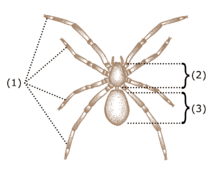
.jpg)

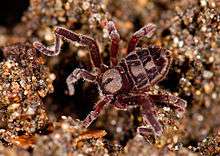

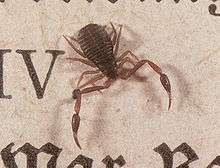
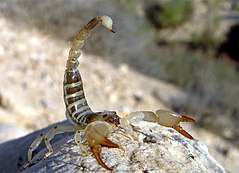
.jpg)
